The real test – 30 hours of sailing!
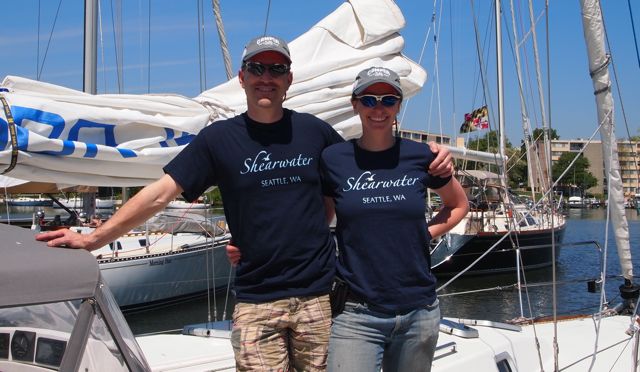
Projects are great, but in the end, the goal is to let loose the lines on a boat – and let it take you places.
Originally, we wanted to take the boat from Annapolis to Newport, RI on this trip, and our preparations were focused on this. On Saturday evening, April 21st, we had managed to complete the critical priority items we had identified, and on Sunday morning, we were ready to see how Shearwater sailed! My mom and John were right there with us (and they had helped us tremendously with plenty of other projects leading up to Sunday). One of the neatest things they did for us was to give us birthday presents that included a canvas boat bag with Shearwater’s name, as well as personalized tees with Shearwater, in the font we had selected for the boat name! How cool is that!?
We cast off the lines and motored out towards the Chesapeake at 3 knots….and once we fueled up, we motored out into the open water of the Chesapeake, roaring along at 2800 rpm’s and 4 knots. 4 knots! The boat should be going at least 7 knots at this RPM! Suddenly, we had our first issue to deal with…issue #1 on the water: boat motoring MUCH slower than it should be at specific engine load. We decided that the likely cause was that the propeller was underpitched (we thought we had addressed this when installing the new MaxProp, but apparently not).
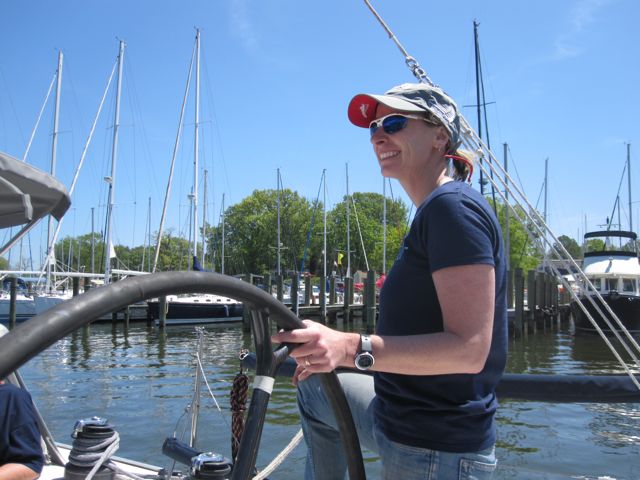
Heading to the fuel dock...motoring along just fine here! Little did we know that 4 knots would be our top speed!
Undeterred, we kept moving, and got the sails up in some pretty light breeze. We were soon able to put up our gennaker that we had installed on a new removable continuous line Selden roller furler – fantastic and easy! The wind died a bit more, so we decided to pull out one of our asymmetrical spinnakers and opted for the slightly smaller 0.75-ounce since we needed to figure things out on the boat. Even more fantastic! We had a very nice afternoon of testing some of our downwind sails, complete with some gybing duels with another boat (full disclosure: I was less than ecstatic about the gybing duels, as every time I went to do something other than sail—and there was plenty that needed done—it was time to gybe because of the shallow Chesapeake waters!).
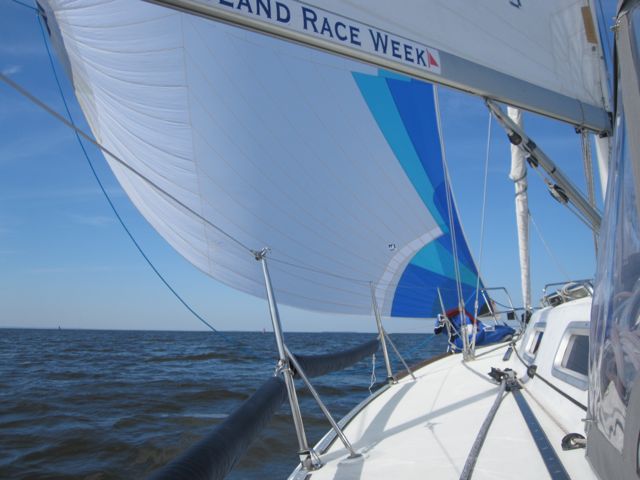
Our 0.75-ounce asymmetrical spinnaker - it took a few gybes to time the turn right, but we've got it now. Fun and fast downwind sailing with this sail!
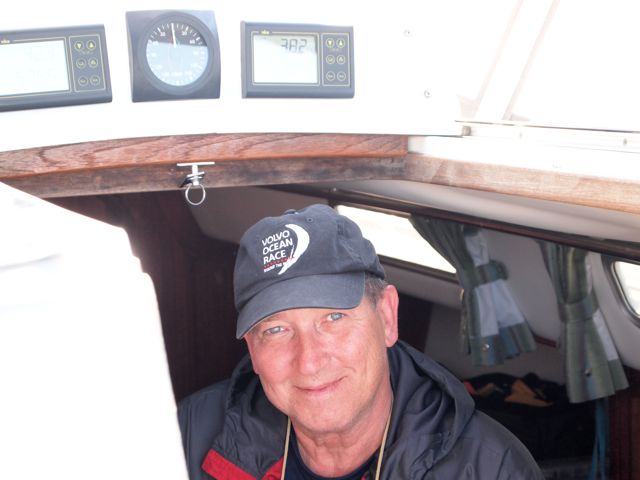
John calling out positions - we had a lot of fun with Navionics and the paper charts - just to be sure, we had 3 iPhones, the iPad and our Maptech charts out!
Nightfall came, and we transitioned to motoring along at our maximum 4 knots into the Chesapeake and Delaware Canal (C&D Canal), where sailing is prohibited anyway. We arrived at our interim destination, Chesapeake City, around midnight, but with the approaching supermoon, zero wind, and a well-lit shoreside, we very gently started easing into anchorage basin. Back in Madrid, Justin had inquired about this basin because on the chart it was clear that with our 7-foot draft we might have depth issues; fortunately the helpful response he got was that a fellow with a 6’ draft had run aground entering the basin, but once inside it was fine. To enter he recommended being close to the Coast Guard station on approach. So we proceeded, left of center, into the basin and at a creepy crawly pace of about 0.5 knots, we slowly came to a keel-dragging-in-the-mud stop. I guess when the fellow recommended going close to the Coast Guard station he meant, right up next to it, so we reversed back into the channel and puttered even slower right up against the pilings on the east side of the entrance with no further issue. We headed for a vacant slip with the depth showing never more than 9 feet, I hopped off the bow of the boat to the dock as we were moving so slowly and started pulling the boat into the slip. I pulled until the boat couldn’t be pulled anymore as we had run aground again trying to inch into the slip. Fortunately, there were other vacant slips at the Cheasapeake Club with a little more water.
The next morning was simply lovely – lots of sunshine and a pleasant motor through the rest of the C&D canal…although we bucked a significant current of almost 2 knots at times, making our progress very slow.
At the end of the canal, Delaware Bay threw a party for us, turning on the breeze and switching the tide so that we now had a favorable current. Unfortunately, our breeze was straight on the nose, and the channel was sadly quite narrow (and we had to accommodate shipping and other traffic), so our progress remained slower than we had hoped. The breeze built, though, and we were able to see how Shearwater handled 20+ knots and building seas that resulted from adverse current and wind. Happily, the boat sailed incredibly well – balanced and solid! Unhappily, we discovered water in the bilge that we presumed to be entering the boat from a few sources: a leaking port was allowing green water in the v-berth, and we think our 15-year old Volvo dripless shaft seal was leaking significantly. We implemented bilge watches into our day and worked our bilge pump a bit to keep things as dry as we could.
Later in the afternoon, after assessing our situation and the approach to Cape May, we decided to turn around and return to Annapolis. Our decision was based on:
- We had another 30+ miles to reach Cape May, and we would have had to approach in the dark. We generally avoid night approaches for unknown harbors (we did approach Chesapeake City at night, after being in the C&D canal, but the entire route was extremely well-lit and well-marked, and it was nearly impossible to be off-course). The approach to Cape May is pock-marked by shoals and requires that sailboats make an enormous detour to properly approach the channel entrance.
- We were facing an approaching tide switch that would further increase the height and steepness of the waves.
- We had no working autopilot.
- We had issues with water in the bilge and our underpitched propeller.
- For us, Newport and Annapolis were nearly equal with respect to where we wanted our boat to be. Newport was the port where we could place the boat on a ship, in the event that we chose to have the boat shipped to Europe. However, our preference is to take it across ourselves, and we could start from either place.
After making the decision to turnaround, we eased the sheets and simply flew downwind in the 25-knot breeze! After a few gybes that were a bit hard on the rigging, including one that broke our boom vang line, we opted for some chicken gybes (in the future, we’ll be bringing in the main sheet much more and then doing a quick release). We later furled our headsail and continued on main alone once nightfall hit. In the future, we might consider dropping the main altogether and only using the headsail for even easier gybing. We’ll also be considering boom preventer options. Our progress back to Chesapeake City was lightning fast in comparison to how long it took us to get out into the Delaware – 8 hours, in comparison to 11 hours to get out. It was a 19-hour day for us, but really, we learned so much, and we had a fantastic opportunity to see how the boat handled in breezier and choppy conditions. Invaluable…
We slept like zombies that evening, and then the next day, we walked into the sleepy little town of 3000 of Chesapeake City to see if a rental car was even a remote possibility to be able to get my mom and John to Cape May, where they had left a vehicle. No problem getting the rental car, even though they were located one town over, as Enterprise Rent-A-Car picks you up! We recuperated a bit, with a fantastic lunch in Cape May (so we did make it, in a way) and then a relaxing drive back to the boat. We were back early enough to spend some time messing with the autopilot again (but challenged again by not having a large enough chuck in our drill to accommodate a large drill bit needed for the installation).
The next day, we sailed for the entire day, except for the short distance to leave the C&D canal and the entrance back into Bert Jabins’ marina. Shearwater is easy to sail, has a responsive helm, and is pretty comfortable in terms of cockpit seating and driver visibility.
Over the three days of sailing, we logged about 200 miles, sailed 30 hours, and motored about 12 hours, mostly in the C&D canal (twice!). We were able to play with 2 of our downwind sails (the 0.75-ounce asymmetrical spinnaker and our gennaker on the furler). We tested the boat in 25+ knots both upwind and downwind, as well as in some steep, current-driven waves. We’re incredibly pleased with the sailing performance.
We have a few things that we’ve noticed that we’d like to improve upon:
- Installing a boom preventer
- Adding rope clutch labels
- Adding some blocks that will function for twinglines, barberhaulers and possibly the boom preventer
- Rebedding the tackline fitting, in the event that water is entering the pole and running into the v-berth
- Moving our anchor so that it does not scratch the pole when we extend the pole
Our maiden voyage was a success!
Sign up to receive blog updates
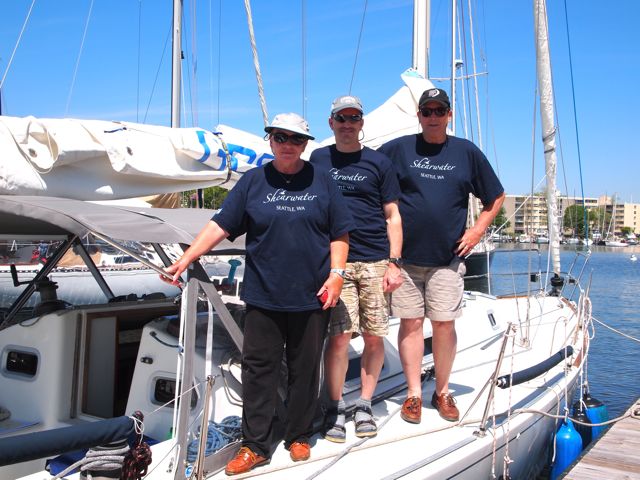
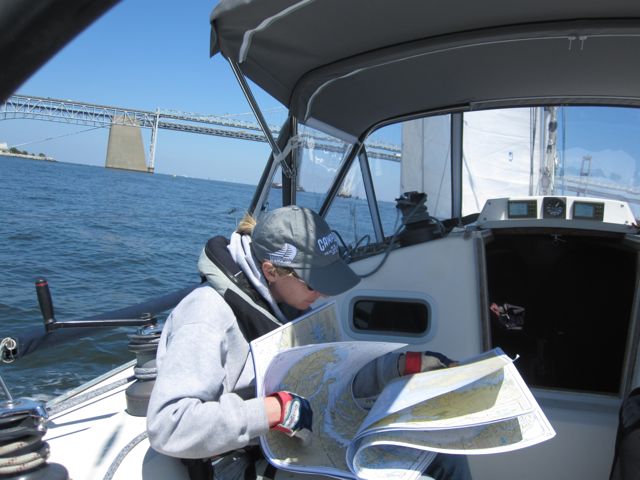
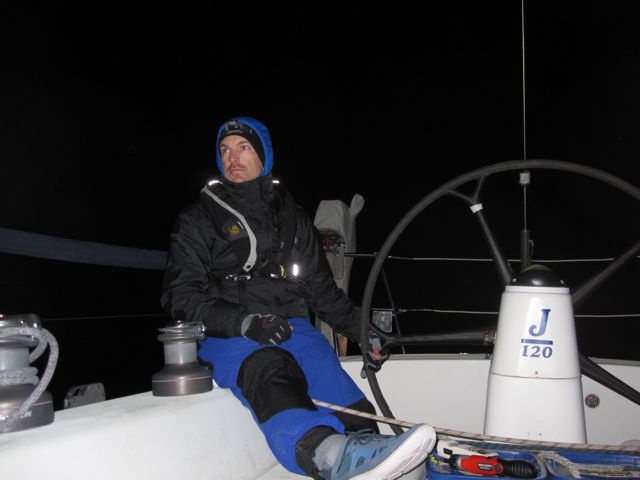
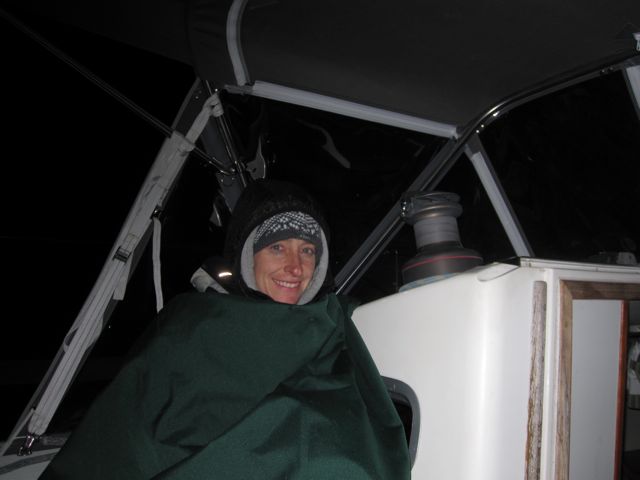
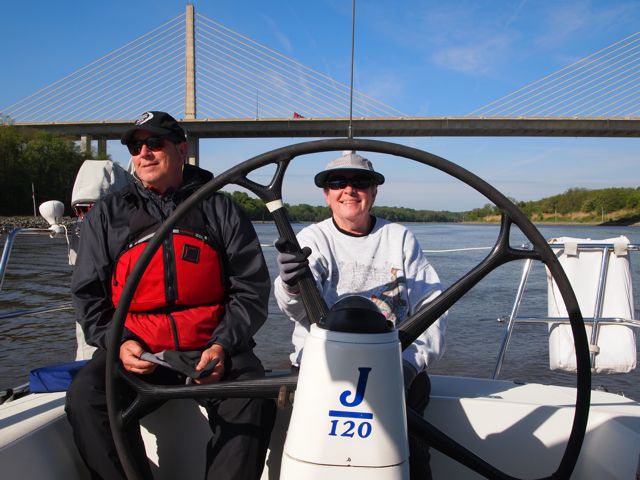
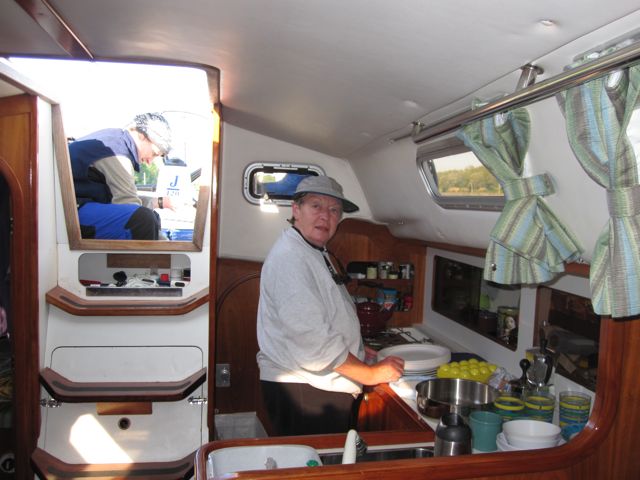
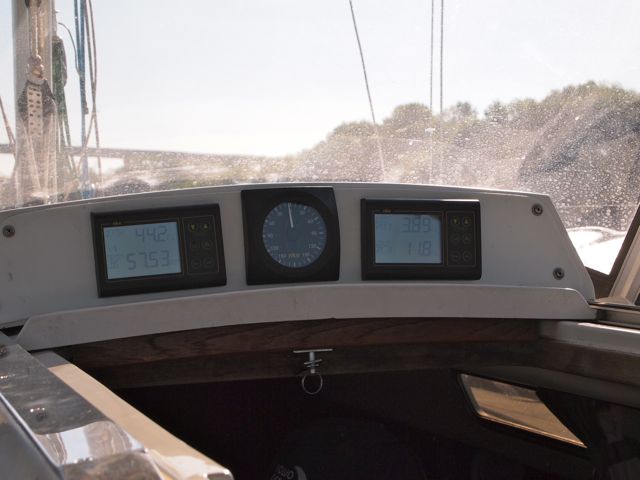
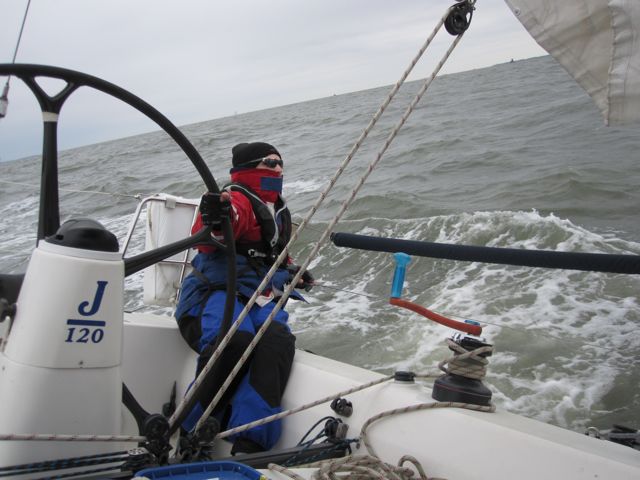

Leave a Reply